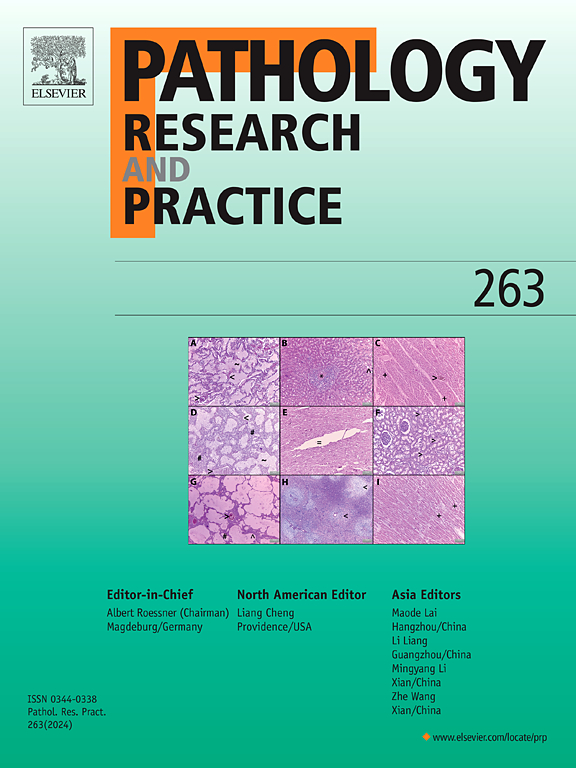肿瘤细胞表面肝细胞生长因子激活物抑制剂-1的缺失可预测食管鳞状细胞癌的不良预后。
IF 2.9
4区 医学
Q2 PATHOLOGY
引用次数: 0
摘要
肝细胞生长因子激活因子抑制剂-1 (HAI-1)是一种上皮型1跨膜蛋白酶抑制剂,调节肝细胞生长因子激活因子和2型跨膜丝氨酸蛋白酶的细胞周活性。它在层状鳞状上皮中强烈表达,并在细胞表面起作用。我们之前报道过HAI-1在口腔鳞状细胞癌侵袭前的细胞表面免疫反应性降低。本研究探讨食管鳞状细胞癌(ESCC)术后细胞表面HAI-1 (csHAI-1)与预后的关系。并在体外分析HAI-1敲低对体外培养的ESCC细胞的影响。HAI-1在正常食管上皮中表现出明显的细胞表面免疫反应性。相比之下,癌细胞中HAI-1免疫反应性的改变是常见的,表现为异常的胞浆内定位和细胞表面免疫反应性降低。csHAI-1免疫反应性的保存是ESCC细胞良好分化表型的标志。降低的csHAI-1与患者的总生存期(OS)和无病生存期(DFS)缩短有关。在55例早期(T1) ESCC病例中,csHAI-1的下降也预示着较差的OS和DFS。HAI-1的缺失增强了体外ESCC细胞的迁移和侵袭能力。这些结果表明,HAI-1细胞表面免疫反应性降低与ESCC分化程度低和预后差有关。细胞表面定位的HAI-1可能是预测ESCC复发和预后的一个有希望的标志物。本文章由计算机程序翻译,如有差异,请以英文原文为准。
Loss of tumor cell surface hepatocyte growth factor activator inhibitor-1 predicts worse prognosis in esophageal squamous cell carcinoma
Hepatocyte growth factor activator inhibitor-1 (HAI-1) is an epithelial type-1 transmembrane protease inhibitor that regulates the pericellular activities of hepatocyte growth factor activator and type-2 transmembrane serine proteases. It is strongly expressed in the stratified squamous epithelium and functions on the cell surface. We previously reported that the cell surface immunoreactivity of HAI-1 was reduced at the invasion front of oral squamous cell carcinoma. In this study, we investigate the relationship between cell surface HAI-1 (csHAI-1) and prognosis of esophageal squamous cell carcinoma (ESCC) after surgery. The effect of HAI-1 knockdown on cultured ESCC cells was also analyzed in vitro. HAI-1 exhibited distinct cell surface immunoreactivity in normal esophageal epithelium. In contrast, alterations in HAI-1 immunoreactivity were frequent in cancer cells, which exhibited aberrant intracytoplasmic localization and decreased cell surface immunoreactivity. The preservation of csHAI-1 immunoreactivity was a sign of a well-differentiated phenotype of ESCC cells. The decreased csHAI-1 was associated with shorter overall survival (OS) and disease-free survival (DFS) in the patients. In 55 cases of early (T1) ESCC cases, decreased csHAI-1 also predicted poor OS and DFS. The loss of HAI-1 enhanced migration and invasion of ESCC cells in vitro. These results suggest that the decreased cell surface immunoreactivity of HAI-1 is associated with a less differentiated phenotype and worse prognosis in ESCC. The cell surface-localized HAI-1 may serve as a promising marker for predicting recurrence and prognosis of ESCC.
求助全文
通过发布文献求助,成功后即可免费获取论文全文。
去求助
来源期刊
CiteScore
5.00
自引率
3.60%
发文量
405
审稿时长
24 days
期刊介绍:
Pathology, Research and Practice provides accessible coverage of the most recent developments across the entire field of pathology: Reviews focus on recent progress in pathology, while Comments look at interesting current problems and at hypotheses for future developments in pathology. Original Papers present novel findings on all aspects of general, anatomic and molecular pathology. Rapid Communications inform readers on preliminary findings that may be relevant for further studies and need to be communicated quickly. Teaching Cases look at new aspects or special diagnostic problems of diseases and at case reports relevant for the pathologist''s practice.

 求助内容:
求助内容: 应助结果提醒方式:
应助结果提醒方式:


